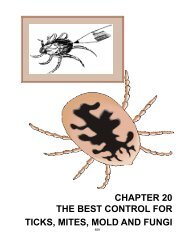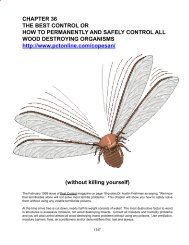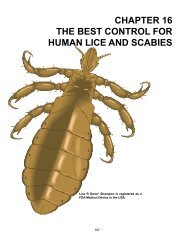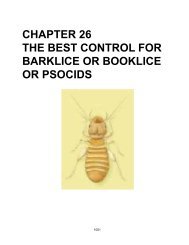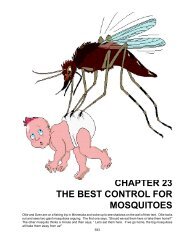You may be highly allergic to this plant.Quaker Oats - for past pain relief. Mix 2 cups oats and 1 cup water in a bowl; warm in the microwave for 1minute. Cool slightly and apply the mixture to your hands for soothing relief from arthritis pain.Quarantine and Exclusion - Quarantining materials in an area to exclude unwanted pest organisms is an IntelligentPest Management® concept of long standing. Quarantining pest infested areas until you can deal withproper control is a vital tool.Quartz Sand - can be used as a repellent.Quassia (Quassia amara) - Used as an insecticide and/or repellent. Boil ¼ cup quassia clips in 1 gal. water for2 hours; cool and use as an insecticidal spray; it will kill mosquito larvae and can be used a moth-proofing agent.Radiant Heat Weeders - Radiant heat or infrared weeders have a lethal head capable of reaching temperaturesof 1800 degrees. Some models use combinations of air, water and radiant heat. <strong>The</strong> most common setup usesa ceramic heating element capable of reaching extremely high temperatures. When you direct the heat towardsthe weed, the intense heat boils the liquids in the plant’s/pest weed’s cells causing them to literally burst. <strong>The</strong>weeds do not even need to be scorched. <strong>The</strong> leaves wilt immediately. <strong>The</strong> element needs to be ½” above theweed and will kill not only the weed but wind-borne seeds and bacteria on or just below the soil’s surface. <strong>The</strong>time to kill is generally 1 - 2 seconds. You can see when you are through, the leaves wilt and turn a darkergreen. <strong>The</strong>y run on propane and weed control costs about 2¢ to 7¢ per 100 sq. ft. <strong>The</strong>re are no open flames,but you must be extremely careful.Radio Waves - May repel some pests initially, but may also be harmful to humans and pets.Radios - can often keep many mammals away from specific areas. See music/noise.Radishes - Plant radishes or nasturtiums with your cucumbers to control cucumber beetles. Pliny in his Book 19emphasized the “great antipathy between radishes and vines, which shrank away from radishes planted near them.Note: Grape vines will also not grow near cabbages. Radish juice in the soil completely inhibits some species.Ragweed (Ambrosia artemisiifolia) - <strong>The</strong> pollen causes allergies, but if you chew on a leaf it may alleviate yoursymptoms instantly. If it does not stop the symptoms immediately, do not continue chewing.Rape Seed Oil - See <strong>The</strong> Great Can-ola. Rape seed oil is toxic because it contains significant amounts of apoisonous substance called erucic acid. Canola oil is a poisonous substance, an industrial oil that does notbelong in the body. It contains “the infamous chemical warfare agent mustard gas,” hemagglutinins and toxiccyanide-containing glyocides; it causes mad cow disease, blindness, nervous disorders, clumping of blood cellsand depression of the immune system. This is what detractors say about canola oil.http://www.westonaprice.org/knowyourfats/conola.htmlRat-proofing - In 13 B.C.E. the first rat-proof granary was built by the Roman architect, Marcus Poliio.Rattlebox (Crotalaria spp.) - Plants will reduce the numbers of a wide number of parasitic nematodes in the soil.Rayless Chamomile (Matricaria matricarioides) - <strong>The</strong> powdered heads are fairly toxic to diamondback moths.Read the Label - Read the label. Read the label and then know all of the information before you use any product.Record Keeping - is essential to monitor trends and patterns in pest problems.Red - Some insects avoid the color red because it registers as a black void in their field of vision.Red Croquet Balls - coated with Vaseline ® or STP or Tanglefoot or a commercial insect adhesive hung at eyelevel just within the apple tree canopy but not totally obscured by the leaves will trap egg-laying female applemaggots. Use one ball per dwarf apple and/or 4 - 8 per full-size apple tree. Paint old burned-out light bulbs448
ight red and cover them with petroleum jelly.Red Food Dye - Will kill many insects including medflies when they ingest leaves and other food materials thathave been sprayed with diluted dye. <strong>The</strong>y die from the ammines.Red Lights - let you get close enough to roaches, carpenter ants and other nocturnal pests to “pet” them, sosimply vacuum them up. Put corn starch (1 tablespoon) in a dry vac or 4 oz. of enzyme cleaner in a quart ofwater in a wet vac to kill the pests you vacuum up.Red Packing Envelopes - with glue on the back can be stuck on a wall and/or behind an appliance, etc. on a45 o angle. Stick open and baited with light Karo syrup and a ½% sodium borate bait.Reflective Tape - will scare away birds.Refuge Habitats - Just one more alternative pest management practice. Allows for growth of beneficial organisms.Registered Pesticide (Poisons) - is just another oxymoron for many reasons. Often only 1% or less of the poisoncompound/formula is tested or extended rather than registered. Other times different federal agencies lookat the poison from far different perspectives and issue completely opposite “warnings” and “directions”. Oftenthe exact same product is a poison for one use and a non-poison for the next use, e.g., disodium octoboratetetrahydrate or sodium borate; when sold as a wood fire retardant, Poly-bor ® , it is not a registered pesticide;when it is sold as a wood treatment for wood destroying organisms, Tim-bor ® , it is a registered pesticide; whensold as a fertilizer, Solu-bor ® , it is not a registered pesticide; when it is sold to mop floors, Mop-Up ® , it onceagain magically becomes a registered pesticide poison. Confused? <strong>The</strong> Author is too; there, obviously, is nologic behind registration.Regular Maintenance Checks - Walk around the entire area to inspect previous infestation sites and to ensureall pest-proofing measures are still intact. Reduce moisture and many pest problems are also reduced.Relative Humidity - Reduce the relative humidity and you control many pests, e.g., dust mites, roaches andbed bugs. Reduce moisture and many pests problems will also be reduced.Remove Plant Debris - and you help to remove disease and pest problems.Repair and Replace - Preventative and ongoing maintenance programs prevent future pest invasions and, ifdone properly, prevent costly major repairs.Repellent and/or Deterrent Chemicals - can be used to protect people, plants and/or animals from parasitesand predators.Repellent Planting - Many plants naturally repel pests. Put some in a blender with some water and some soapto make your own repellent spray or scatter their leaves around to repel pests. Garlic repels most insects.Research - Every day the Author learns another alternative contol; research must be constantly performed.Resistance - <strong>The</strong> ability of the pest to become immune to a particular pesticide poison or microorganism to becomeimmune to an antibiotic. At some point all synthetic pesticides/medicines will fail to control pest/infectionproblems. Resistance is the natural, inherited ability of a living organism to adapt in order to survive a particularpesticide/mrdicine that would normally give effective (but not safe) control. As early as 1993 greater than 504insect species were known to be resistant to at least one formulation of insecticide and at least 17 species ofinsect species are resistant to all major classes of insecticide. 150 fungi and other plant pathogens are resistantand several plant pathogens are resistant to nearly all systemic fungicides used against them. Five kinds ofrats are known to be resistant to the chemicals that are used against them. Resistance to herbicides have beendocumented in over 100 weed biotypes and 84 species (Cate and Hinkle 1994).<strong>The</strong> green peach aphid, Myzus persicae (Homoptera: Aphidae), is resistant to more insecticides than any otherinsect. Two other agricultural pests that are notoriously resistant, the Colorado potato beetle, Leptinotarsa449
- Page 1:
CHAPTER 11SAFE AND FAR MOREEFFECTIV
- Page 4 and 5:
pesticide poisons do - to them the
- Page 6 and 7:
American Beautyberry (Callicarpa am
- Page 8 and 9:
packets in 4 days or less. Aspartam
- Page 10 and 11:
Baking Soda - Baking soda or sodium
- Page 13 and 14:
Bioderivatives - are substances whi
- Page 15 and 16:
Bird feeders - will attract more th
- Page 17 and 18:
an abrasive action on the insect wh
- Page 19 and 20:
pathogens - volatiles produced duri
- Page 21 and 22:
ground, grain and stored product ap
- Page 23 and 24:
epels many insects, including flies
- Page 25 and 26:
een used medically since at least t
- Page 27 and 28:
Collateral Damage - When you spray
- Page 29 and 30:
Cottonseed Meal - is a source of ni
- Page 31 and 32:
Desiccants - Hot air, dehumidifiers
- Page 33 and 34:
Dogs - have been trained to sniff o
- Page 35 and 36:
elderberry leaves to protect them f
- Page 37 and 38:
controls pests and acts as a deodor
- Page 39 and 40:
contamination that no one can hones
- Page 41 and 42:
Chlorphyll Graphite Parrafin wax Wa
- Page 43 and 44:
Film Capsule - The plastic capsule
- Page 45 and 46:
Repel roaches with bay leaves and e
- Page 47 and 48: person in your house, but you’ll
- Page 49 and 50: slender sickle-shaped jaws. They ap
- Page 51 and 52: epellent that contains only natural
- Page 53 and 54: infusion of pignut leaves, rubbed o
- Page 55 and 56: Human Hair - cut in small pieces wi
- Page 57 and 58: Insect Diseases - In 1836, Agostino
- Page 59 and 60: Irrigation Management - Improper ir
- Page 61 and 62: lack cutworms.Laxatives - Chocolate
- Page 63 and 64: we die. Check out magnesium in Chap
- Page 65 and 66: Milk Thistle - is a proven detoxifi
- Page 67 and 68: Moon Flower (Datura ioxia) - Do not
- Page 69 and 70: Spotted knapweed begins producing c
- Page 71 and 72: Nothing - Doing nothing is a choice
- Page 73 and 74: fertilizers and sprays will normall
- Page 75 and 76: added to enzyme cleaners or when us
- Page 77 and 78: yellow to yellow crystalline solid
- Page 79 and 80: Aureolaria virginica (L.) Pennell.
- Page 81 and 82: Clematis vitalba L. (Honduras fish
- Page 83 and 84: Euphorbia bicolor Engelm. and Gray.
- Page 85 and 86: Justicia adhatoda L. (Adhatoda vasi
- Page 87 and 88: Momordica charantis L. (Balsam-pear
- Page 89 and 90: Piper nigrum L. (Black pepper).Stro
- Page 91 and 92: Sesamum indicum L. (S. orientale L.
- Page 93 and 94: Xanthorrhoea hastilis R. Br. (Black
- Page 95 and 96: Pomander - Repel moths and other in
- Page 97: y Safe Solutions at 1-888-443-8738
- Page 101 and 102: a wide variety of antioxidants call
- Page 103 and 104: Sawdust - Sawdust can be treated wi
- Page 105 and 106: lit charcoal in the tunnels would a
- Page 107 and 108: Active IngredientGeneric Name Trade
- Page 109 and 110: Sour Milk - sprays will loosen scal
- Page 111 and 112: Stay Calm - Take a deep breath amd
- Page 113 and 114: to make the mix about the consisten
- Page 115 and 116: pesticides have never controlled or
- Page 117: Temperature - Increase or lower tem
- Page 120 and 121: in colder climates. The most fragra
- Page 122 and 123: and/or dehumidifiers, plumbing and
- Page 124 and 125: odents, scorpions, etc. to your bai
- Page 126 and 127: Oregano also contains four anti-ast
- Page 128 and 129: like colds, and headaches and spend
- Page 130 and 131: then estimated human population. Gi
- Page 132 and 133: “The choice, after all, is ours t
- Page 134: 484



